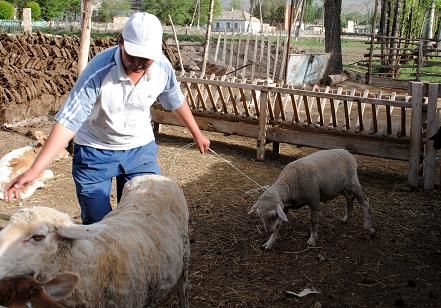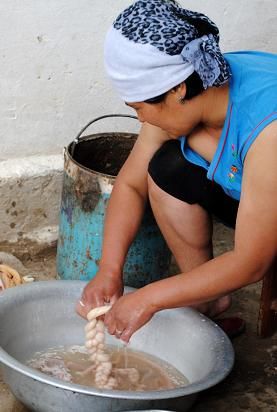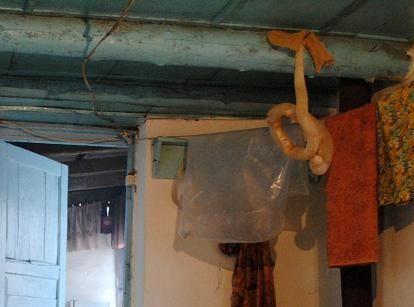June 10, 2013
WARNING: This post contains graphic images of a sheep being slaughtered.
WARNING: This post contains graphic images of a sheep being slaughtered.
Altynbek was gone most of
the day yesterday at some sort of political meeting two villages west of here.
He returned around 6pm, at which point I was told that they would be
slaughtering a sheep “in my honor.” Now I don’t know how often they slaughter
sheep in this family, but given that we consume sheep two to three meals a day,
this surely is a frequent occurrence. I suspect that the “in my honor” thing is
just their way of being polite. Of course, other than when we slaughtered a sheep in honor of the birth of Jumabek’s granddaughter, I haven’t witnessed the
slaughtering of any sheep, so who knows. Of course, I definitely had mixed
feelings about being told that this particular sheep was being slaughtered
specifically for me (whether that was the entire truth or not). I mean, I’m not
a vegetarian, and I have been eating sheep essentially every day for the past
month. And just a few days ago I watched the slaughter of one of Jumabek’s
sheep without flinching… but being told that an animal is being killed
specifically for you is rather disconcerting.
Altynbek led the sheep out
of its enclosure and over to the area in the courtyard next to the yurt. He
tied its feet together and then we stood in a row facing west to pray ‘omin.’ I
silently prayed to the sheep: “Dear sheep, I’m sorry. I thank you for your
sacrifice. I will try to enjoy eating you.” It’s somewhat disconcerting to
watch how rapidly something goes from being alive to being… not. It’s something
that – unless you’re a hunter or a farmer – most people back home rarely think
about.

The slaughtering and
butchering process followed the exact same pattern as it had the previous time
at Jumabek’s. This time I observed the whole slaughtering and butchering
process from a much closer vantage point. It occurred to me that kids out here
have a much better grasp of anatomy than kids back home. I remember in 10th
grade when we dissected fetal pigs and struggled to locate the various internal
organs. In contrast, kids here learn from a very young age how to locate and identify
all of the various internal organs. And unlike me and my 10th grade companions,
they do it without flinching.





After the sheep was
slaughtered and butchered we went into the big external kitchen located behind
the house. It’s been there since the original house (not the new, two-story
house they currently live in, but the older one next to it) was built. It is
the place where all of the cooking is done. The “kitchen” inside the new house
is a fairly sterile place with a hotplate and an electric tea kettle – no stove
or running water. The real cooking is done out in the external kitchen, which
contains several wood-burning stoves, and a large wooden table. (Underneath the
wooden table is a ladder descending into a large, underground root-cellar.) It
also had what appeared to be an inflated and dried large intestine hanging from
the ceiling.

First Altynbek lit the fire
– filling the place with smoke – then he placed the portions of the sheep that
we were going to consume in a vat above the fire where they began to boil. The
remaining cuts of meat and various internal organs were brought inside and
spread out on the large wooden table.
Rakhat began chopping the
liver and several other unidentifiable (at least to me) internal organs, which
she then mixed with rice, salt, pepper, and a smidgeon of flour. She then took
the dried large intestine (yes, that’s what it was) down from the ceiling. Apparently
the large intestine is soaked in brine for a week or two, then blown up and
hung up to dry. This one was from the last sheep that they had slaughtered. The
large intestine from “my” sheep was then placed in brine to soak. The dried
intestine was rehydrated in water, and then filled with the rice-liver-innards
mixture and tied shut. Yes, ladies and gentlemen, this is how you make sausage
(or as Altynbek put it, “Kyrgyz Kielbasa”). The sausages, as well as the
braided small intestines, were then thrown into the vat with the meat that was
already cooking.

Now that the weather has
warmed up, all of the eating and tea drinking takes place in the yurt in the
courtyard. I was told that the meat needed two hours to cook, so I brought my
kindle into the yurt and curled up on a chair. (They’ve rigged a light from the
tunduk – the opening at the top-center of the yurt – so it isn’t dark inside.)
While I was inside reading, a man arrived. This is nothing new; guests pop in
unexpectedly all the time. This guy, however, was actually expected.
He and Altynbek sat and
chatted in Kyrgyz for some time before Altynbek went off to deal with
sheep-cooking issues, at which point this fellow started talking to me. It
turned out that he was the district prosecutor, as well as a distant cousin of
Altynbek. They’d seen each other at whatever the regional meeting was where
Altynbek had spent the bulk of his day, and Altynbek had invited him over to
partake in the freshly killed sheep.
The prosecutor, whose name I
promptly forgot, was an interesting fellow. He had spent some time in Cuba back
in the day, and spoke basic Spanish, roughly on par with mine. We traded a few
phrases back and forth in Spanish, then switched back to Russian. He had spent
time in both St. Petersburg and Vladimir in Russia (both places where I have
lived), so we discussed both cities, and what life was like there, and how that
contrasted to life in both Kyrgyzstan and the US. We also talked about some of
the more current problems throughout European Russia, such as the racism
against Central Asian minorities. He was a tad nostalgic for the former Soviet
Union. He wasn’t one of those who glorified the FSU with memories beginning
with ‘когда
был Советский Союз…” but he did say that before the collapse of the
Soviet Union, everyone seemed to get along: Muscovites and Central Asians,
Kyrgyz and Uzbek, etc., and he could travel throughout the Soviet Union without
fear of racism, unlike today. He also said that while the transfer from
communism to capitalism was extremely difficult for Kyrgyzstan, things were
finally starting to get better.
At this point, the food –
and the booze – was brought out. Booze. Goddamn. Rakhat and Altynbek don’t
drink, meaning that this bottle was destined for me and the prosecutor. Luckily
he was a bit of a lightweight; he had trouble keeping his eyes open after three
shots, and by the fourth he looked as though he might pass out right there at
the table. At that point, Rakhat put the bottle away. For people who don’t
drink, Rakhat and Altynbek seem to take a lot of joy in getting other people
intoxicated! Luckily four shots amounted to less than half of what I’d consumed
with Jumabek so I, unlike my prosecutorial drinking partner, was not too
terribly inebriated. But let’s get back to the sheep.

The beshbarmak came out as a
giant plat filled with meat-covered bones. The meat was perfectly cooked so
that the flesh simply melted off the bone. As tired of sheep as I have become,
I actually found this to be quite tasty. The meat was also accompanied by bowls
of hot, greasy sheep-bullion for each of us, and I was actually able to drink
half of mine. (And I didn’t even drop mine in my lap this time! Haha.) The plate did not merely contain meat-covered
bones, however; it also contained the two sausages and a variety of freshly
cooked innards. I was able to avoid the straight-up innards, although I did eat
a couple of pieces of sausage. The sections that consisted of liver and rice
were pretty tasty. However, the sections that consisted of miscellaneous other
sheep guts… well, let’s just say that my gag reflexes reacted strongly to the
texture (although thankfully in a way that I was able to disguise).
After we gnawed on the bones
for a while, Rakhat cut the meat off the remaining bones and sliced it up into
tiny pieces. She also did the same with some of the guts. This meat/guts
mixture was then placed on a large plate, then topped with homemade pasta and a
liberal dose of sheep-bullion. This was the meat-n-pasta portion of the
beshbarmak, and my companions actually ate it with their hands as well.
(Remember, beshbarmak translates as “five fingers” as this is a meal that is
traditionally eaten with one’s hands.) The pasta was actually quite good,
except for the few moments when my tongue realized it was touching guts. Sigh.




No comments:
Post a Comment